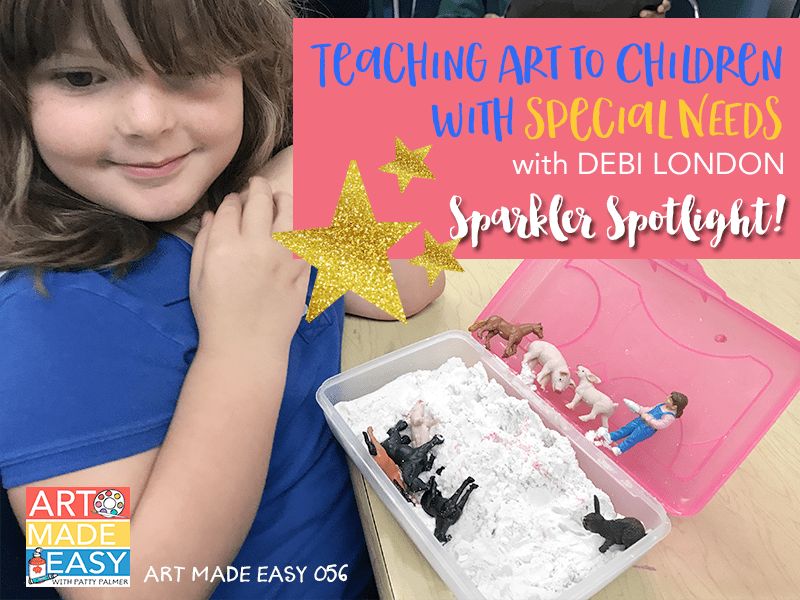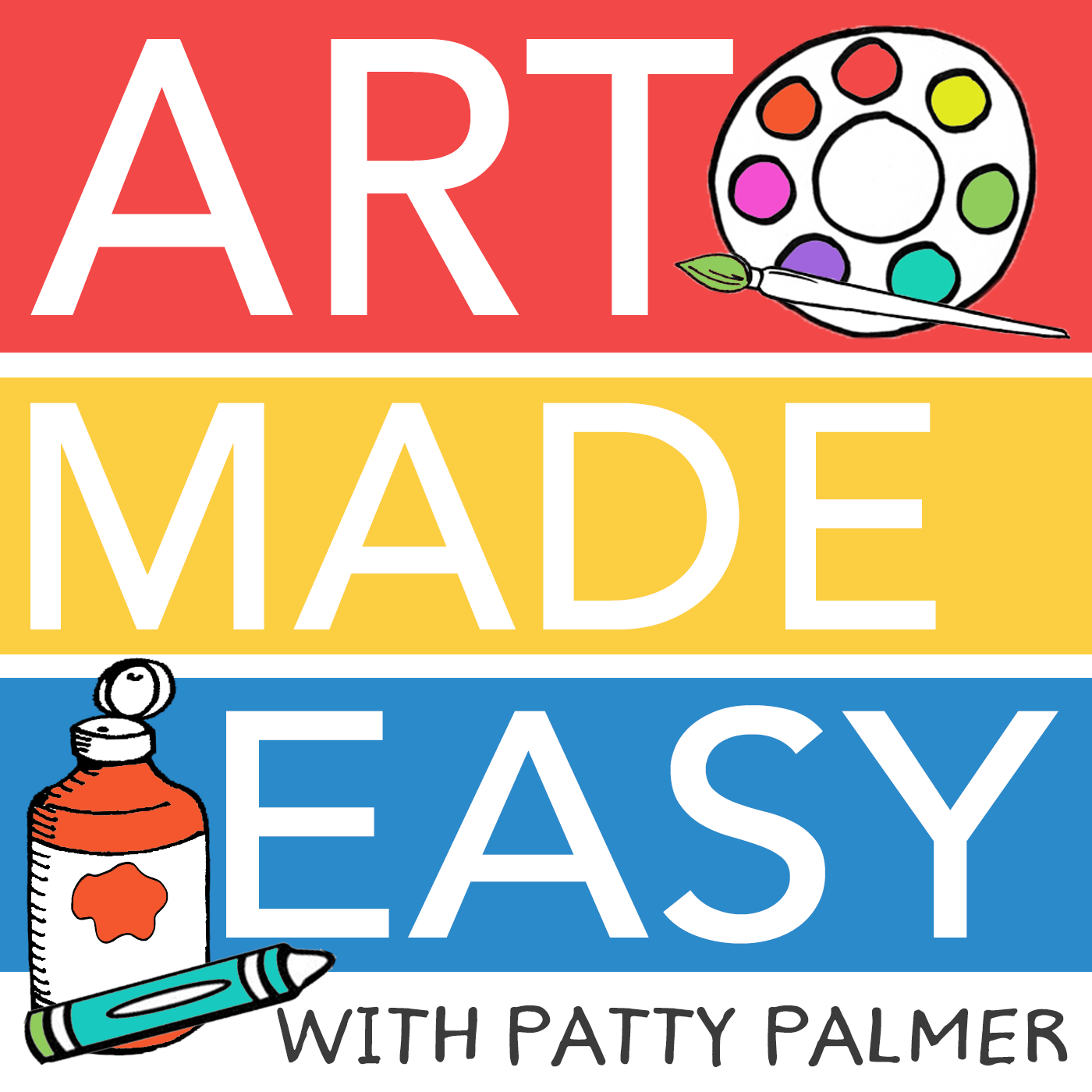
There is a huge effort to mainstream children with special needs but often teachers have no formal training in the special needs area. Debi London experienced this first hand as an art teacher and as a mother of a child with autism how important it is to be aware of the small things a teacher can do to create a warm, nurturing and inspiring environment for all children.
This episode is for art teachers seeking inspiration and guidance from another art teacher who has walked the walk. Learn how Debi approaches her lessons, how she sets up her classroom to accommodate all learners and the resources that have made a difference to her.
IN THIS EPISODE YOU’LL LEARN:
- Helpful tips for helping you to create an art program that is accessible for all children
- Why it’s important to know the specific needs of all your children, including their likes and dislikes
- How a sensory center in the classroom can be used to benefit children with special needs
- How it’s ok to teach at different paces to accommodate specific learning speeds
- Why you need to be aware of and consider each child’s attention span
- How to juggle the needs of all students while maintaining positive reinforcement
LISTEN TO THE SHOW

My best advice for teaching art to kids.
There is a huge effort to mainstream children with special needs but often teachers have no formal training in the special needs area. Debi London experienced this first hand as an art teacher and as a mother of a child with autism how important it is to be aware of the small things a teacher can do to create a warm, nurturing and inspiring environment for all children.
This episode is for art teachers seeking inspiration and guidance from another art teacher who has walked the walk. Learn how Debi approaches her lessons, how she sets up her classroom to accommodate all learners and the resources that have made a difference to her.
IN THIS EPISODE YOU’LL LEARN:
Helpful tips for helping you to create an art program that is accessible for all children
Why it’s important to know the specific needs of all your children, including their likes and dislikes
How a sensory center in the classroom can be used to benefit children with special needs
How it’s ok to teach at different paces to accommodate specific learning speeds
Why you need to be aware of and consider each child’s attention span
How to juggle the needs of all students while maintaining positive reinforcement
LISTEN TO THE SHOW
HERE IS SOME GUIDANCE FOR APPROACHING YOUR LESSONS:
1. Provide a Sensory Center- The student should have access to a sensory sand box (kinesthetic sand is a great option), Lego, blocks, larger paper for coloring or stamping, access to iPads with head phones (students can be noise sensitive). Rain sticks can be soothing. A few bean bags on floor, a small carpeted area and access to a few stuffed animals. Allow movement like: walking and stretching to meet needs.
2. Be understanding of some students because they are unable to fully focus because they: fidget, flap (stem). Allow them to have access to these things at the sensory center area as usage of items will help the flow of teaching art.
3. Soft classical music helps to create a calming environment.
4. Allow for breaks (sometimes a timer helps).
5. Get to know the students. Find out likes and dislikes to avoid a meltdown.
6. Pair students with friends or pair with one-on-one help from teacher.
SHOW NOTES
Monsters Love School Lesson
Eric Carle’s Website
Special Artists Handbook: Art Activities and Adaptive Aids for Handicapped Students by Susan Rodriguez and Paul D. Blumenthal(affiliate link)
My Brother Charlie by Holly Robinson Peete (affiliate link)
Sesame Street: Meet Julia Video
What is Autism?



HERE IS SOME GUIDANCE FOR APPROACHING YOUR LESSONS:
1. Provide a Sensory Center- The student should have access to a sensory sand box (kinesthetic sand is a great option), Lego, blocks, larger paper for coloring or stamping, access to iPads with head phones (students can be noise sensitive). Rain sticks can be soothing. A few bean bags on floor, a small carpeted area and access to a few stuffed animals. Allow movement like: walking and stretching to meet needs.
2. Be understanding of some students because they are unable to fully focus because they: fidget, flap (stem). Allow them to have access to these things at the sensory center area as usage of items will help the flow of teaching art.
3. Soft classical music helps to create a calming environment.
4. Allow for breaks (sometimes a timer helps).
5. Get to know the students. Find out likes and dislikes to avoid a meltdown.
6. Pair students with friends or pair with one-on-one help from teacher.
SHOW NOTES
My Brother Charlie by Holly Robinson Peete (affiliate link)
Sesame Street: Meet Julia Video

My best advice for teaching art to kids.
Yes, the day has come!
After a long time deciding if, I finally said when.
Thank you SO much for your encouragement, show suggestions and help getting Art Made Easy off the ground.
Many of you were so pumped about this show but confessed that you had no idea what a podcast was. I love you guys for your unbridled enthusiasm.
Here’s a quick definition of a podcast & what to expect from Art Made Easy:
A podcast is a free radio show. The host (me!) interviews guests or talks about a favorite subject. You get to listen through your computer, laptop or smart phone. I like to listen to my favorite podcasts in my car during long travel days or on my walks via set of ear buds and my iPhone.
You can subscribe to the show via iTunes and Stitcher radio. The benefit is that your free podcast ap on your iPhone will automatically be updated with all the podcast episodes from any show you subscribe to.
Go ahead and give it a try!
To listen on your laptop or computer, just click the play button in the colored box below.
To listen via iTunes, click on the “play in iTunes” banner and click subscribe.
And now onto the show…
For my first show, I wanted to tell you my story of how I became an art teacher. We all have different paths and this one is mine. I’ll share advice to those who are just starting out as an art teacher and some of my best tips for teaching art to kids.
This episode is for anyone who thinks they may not have the qualifications to be an art teacher. Teaching art to kids doesn’t have to happen inside a classroom. You can teach art at home, at a summer camp and even as a volunteer (like I did).
If you are an art teacher just beginning your journey, I’m sharing my best advice to get you through that tough first year. Download my free handout and keep it in your teacher planner and refer to it when you have a tough day.
LISTEN TO THE SHOW
SHOW NOTES:
Drawing With Children: A Creative Method for Adult Beginners, Too
Art Lab for Kids: 52 Creative Adventures in Drawing, Painting, Printmaking, Paper, and Mixed Media-For Budding Artists of All Ages (Lab Series)
National Art Convention
CreativeLive- free online classes
Art Teachers Facebook Group
Website: Painted Paper in the Art Room (Laura Lohmann)
Website: Art of Education
Book: Classroom Management for Art, Music, and PE Teachers
PS – Please leave a review on iTunes!
Art Made Easy is now live on iTunes! Subscribing to the show and leaving an honest review really helps the show gain visibility and allows me to tailor the show to your needs.













I want to thank Patty for interviewing me and for letting me share my story.
You were awesome Debi! Thank you!
I really enjoyed listening to this podcast. You are awesome Debi! What a patient and kind teacher you are. I appreciate your ideas, suggestions and I LOVE the idea of those little sensory boxes. So fun! What lucky children to have you in their corner.
I’ve been listening to as many of Patty’s wonderful podcasts as I can possibly squeeze in. How to do I get the notes she talked about in the #52 podcast for using tempera paints? I love what she said and have listened 3 times, but I need her suggestions in print so I can follow my clearly and use her suggestions. Even though I’m a professional artist and have been teaching art for more than a quarter of a century, I’m still learning all kinds of new techniques from Patty. Thanks for your help!
Hi Jill,
I don’t have transcripts for my podcasts but that’s something I’m thinking of doing. There are a few posts that you can click through (Show Notes) that help explain the techniques. Just go back to the podcast page and scroll to the bottom to Shownotes. Then, click on the hyperlinks. https://www.deepspacesparkle.com/3-techniques-try-tempera-paint-ame-052/
I was so excited to see this message I’m a special education teacher and have experience in applied behavior analysis. I’ve been a special education teacher for 12 years and worked in various environments but always feel like art is calling me so I would love to combine my love of art and special education experience to teach art to children and adults with special needs. I think art could also be a powerful tool and outlet for parents and siblings too. It was an amazing podcast and I would love to help others if they need help adapting cirrculum or making modifications for their students. I am hoping to someday soon make the leap to teaching more private art lessons and maybe eventually specializing in teaching art to special needs children and adults who knows maybe one day I’ll open a studio. Thank you for your podcast it is a true inspiration and keeps my dream alive daily of how I can be an art teacher to my kids, my students and even those in my neighborhood!
What a beautiful comment Grace Cook. You can do it!